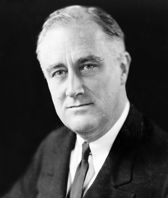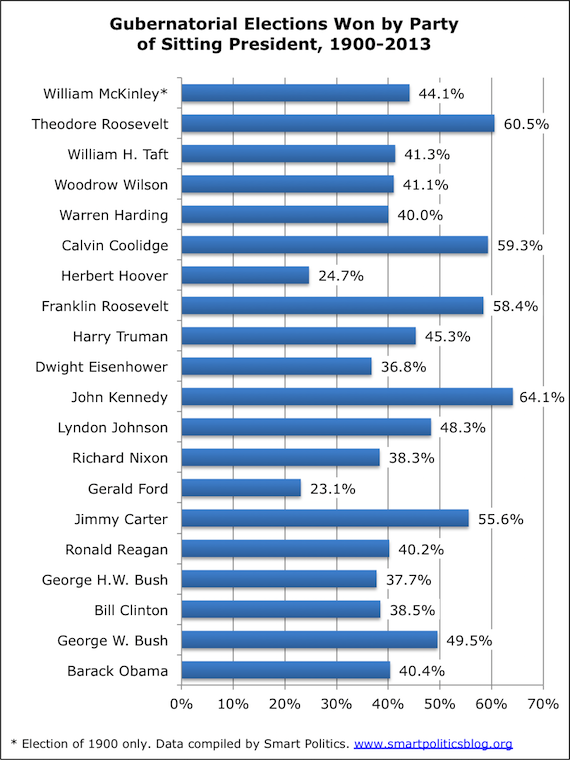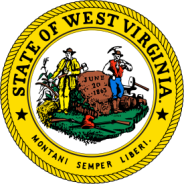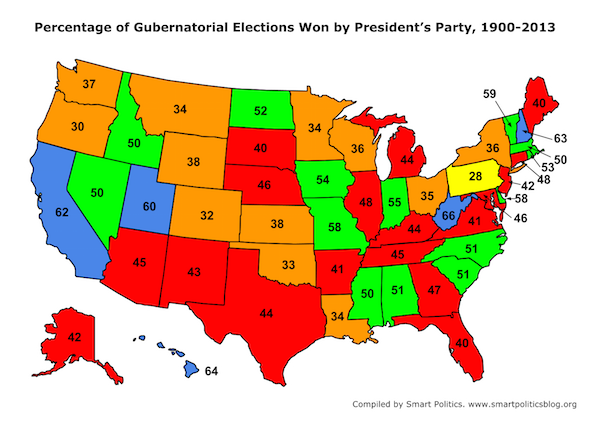Is There a Presidential Drag On Gubernatorial Elections?
Only five of the 20 presidents to serve since 1900 have seen their party win a majority of gubernatorial elections during their administrations, and only one since JFK
 One of the reasons attributed to the expected Democratic losses in the U.S. Senate and U.S. House this fall is, of course, the low approval ratings of President Barack Obama.
One of the reasons attributed to the expected Democratic losses in the U.S. Senate and U.S. House this fall is, of course, the low approval ratings of President Barack Obama.
Indeed, much has been written about the loss of legislative seats of the sitting president’s party in midterm elections over the last century.
But what about races for governor?
Democrats – who shed several gubernatorial seats in the 2010 midterms – will probably lose a majority of the 36 races on the ballot in 2014.
That does not mean all Democratic nominees are necessarily shunning the president this cycle.
For example, Wisconsin Democratic nominee Mary Burke appeared with President Obama in Milwaukee on Tuesday to boost Election Day turnout in her quest to knock Republican Scott Walker out of office.
So is there a presidential drag on races in gubernatorial elections for the president’s party?
Over the past century most presidents have seen their party lose more gubernatorial elections than they have won.
Smart Politics analyzed the more than 1,800 gubernatorial elections conducted since 1900 and found that 15 of 20 presidents endured losses of their party in a majority of gubernatorial elections held during their tenures, with Jimmy Carter the only president to be above water by this measure since John Kennedy.
Overall, the president’s party has been victorious in gubernatorial elections 46.2 percent of the time since 1900, winning 848 races and losing 987.
Democratic gubernatorial nominees have fared slightly better when their party controlled the White House than have Republican nominees with a GOPer in D.C. – due in part to the South backing Democrats in state government through thick and thin for a majority of the 20th Century.
With Democratic presidents running the country, Democrats have been victorious in 48.5 percent of gubernatorial elections, with Republicans winning 49.9 percent of such races and third parties winning 1.5 percent.
When Republicans controlled the White House, GOP gubernatorial nominees were elected 44.2 percent of the time, with Democrats winning 55.2 percent and third parties winning 0.6 percent.
Variation Across Presidencies
To be sure, most presidents have seen their party take losses in gubernatorial elections during their administrations and Barack Obama is no exception heading into the 2014 contests.
Of the 20 presidents to serve since 1900, only five have seen their party win a majority of elections for governor: Republicans Teddy Roosevelt and Calvin Coolidge and Democrats Franklin Roosevelt, John Kennedy, and Jimmy Carter.
Kennedy, who was in office while 39 gubernatorial elections were conducted from 1961 to 1963, saw Democrats win 25 of them, or 64.1 percent – highest among presidents to serve in the 20th and 21st Centuries.
Teddy Roosevelt is next, with Republicans winning 60.5 percent of races for governor from 1901 through 1908 (89 of 147 contests).
No other president over the last 110+ years saw his party win 60 percent of the races for governor while he was in office.
Calvin Coolidge came close, with Republicans carrying 67 of 113 elections for governor from 1923 through 1928, or 59.3 percent.
 Democrats won 125 of 214 gubernatorial elections during the tenure of Franklin Roosevelt between 1933 and 1944, or 58.4 percent.
Democrats won 125 of 214 gubernatorial elections during the tenure of Franklin Roosevelt between 1933 and 1944, or 58.4 percent.
Roosevelt, of course, was in the White House during the Democratic waves of 1934 and 1936 when the party won 73.5 percent (25 of 34) and 80 percent (28 of 35) of gubernatorial elections respectively.
Including the few contests that were held in 1933 and 1935, Democrats were victorious in 77.8 percent of the gubernatorial races held during Roosevelt’s first term (56 wins, 16 losses).
That pace was unsustainable, however, and FDR saw his party win less than half of the races for governor conducted over the next eight years of his administration through the Election of 1944 – winning just 69 of 142 elections, or 48.6 percent.
The only other president to serve in the White House since 1900 and see his party win a majority of gubernatorial seats was Jimmy Carter.
Democrats claimed 30 of 54 gubernatorial elections while Carter was in office (55.6 percent) including 21 of 36 in the 1978 midterms and even six of 13 in 1980 when Carter was trounced in his reelection bid.
During the 1980 cycle, Democrats prevailed in Montana (Ted Schwinden), New Hampshire (incumbent Hugh Gallen), North Carolina (incumbent Jim Hunt), Rhode Island (incumbent John Garrahy), Utah (incumbent Scott Matheson), and West Virginia (incumbent Jay Rockefeller) despite Carter’s approval ratings hovering in the mid-30s on Election Day.
Carter is the only president since John Kennedy to be above water by this measure.

 
The remaining 15 presidents to serve in the 20th and 21st Centuries all saw their parties lose more gubernatorial races than they won.
The Republican Party came quite close to breaking even during the George W. Bush years – winning 52 of 105 races during his administration, or 49.5 percent.
Republican gubernatorial candidates were 30-23 during Bush’s first term but just 22-30 in his second.
Lyndon Johnson has the seventh best mark during this span at 48.3 percent (42 of 87) – buoyed in large part by the Election of 1964 when Democrats won 18 of 26 seats.
Next is Harry Truman at 45.3 percent (63 of 139), William McKinley (1900 only) at 44.1 percent (15 of 34), William Howard Taft at 41.3 percent (31 of 75), and Woodrow Wilson at 41.1 percent (62 of 151).
And where does Barack Obama rank?
Heading into the 2014 midterms, Barack Obama is #12 of the 20 presidents to serve since 1900 – with Democrats winning 23 of 57 gubernatorial elections during his administration, or 40.4 percent of the time heading into the 2014 midterms.
That ranks slightly ahead of Ronald Reagan at 40.2 percent (43 of 107), Warren Harding at 40.0 percent (14 of 35), Bill Clinton at 38.5 percent (40 of 104), and Richard Nixon at 38.3 percent (23 of 60).
Rounding out the bottom four slots are George H.W. Bush at 37.7 percent (20 of 53), Dwight Eisenhower at 36.8 percent (50 of 136), Herbert Hoover at 24.7 percent (18 of 73), and Gerald Ford at 23.1 percent (12 of 52).
Midterm Blues
The parties of both Democratic and Republican presidents have suffered greater losses in gubernatorial elections in midterms than other election years, but particularly on the Democratic side.
Overall, the party of the sitting president has won 43.3 percent of midterm gubernatorial elections (410 of 947 contests) compared to 49.3 percent (438 of 888) in other election cycles.
When a Democrat is in the White House, Democrats have won 54.0 percent of races for governor in presidential and odd-numbered election years (216 of 400) but just 43.6 percent during the midterms (194 of 445).
The Republican Party has won 43.0 percent of races during midterms with a GOPer in the White House (216 of 502) and slightly more, 45.5 percent, in other cycles (222 of 488).
Variation in the States
Not only has there been significant variation between presidents as to how well the party of the president fares in gubernatorial elections, but also across the 50 states.
At the top of the list are five states which have voted into office a nominee from the sitting president’s party more than 60 percent of the time: West Virginia, Hawaii, New Hampshire, California, and Utah.
 West Virginia leads the way at 66.7 percent – casting its gubernatorial vote for the party of the sitting president in 20 out of 30 contests since 1900.
West Virginia leads the way at 66.7 percent – casting its gubernatorial vote for the party of the sitting president in 20 out of 30 contests since 1900.
That includes each of its last two elections for governor – a special in 2011 and 2012 – despite Obama being particularly unpopular in the Mountain State.
Hawaii is next at 64.3 percent (nine of 14), followed by New Hampshire at 63.2 percent (36 of 57), California at 62.1 percent (18 of 29), and Utah at 60.0 percent (18 of 30).
Overall, 16 states have voted into office governors of the sitting president’s party more than half of the time.
The remaining 11 states are Vermont (59.6 percent), Delaware (58.6 percent), Missouri (58.6 percent), Indiana (55.2 percent), Iowa (54.3 percent), Rhode Island (53.4 percent), North Dakota (52.2 percent), Alabama (51.7 percent), North Carolina (51.7 percent), South Carolina (51.4 percent), and Massachusetts (50.9 percent).
Nine of these 16 states hold elections in 2014 with Democrats favored to win (and boost their percentages) in California, Hawaii, New Hampshire, Rhode Island, and Vermont.
Republicans are favored in Alabama, Iowa, and South Carolina while Massachusetts is a toss-up.
In some states, however, being a nominee of the president’s party has been a recipe for disaster in gubernatorial races since the turn of the 20th Century.
At the bottom of the list is Pennsylvania.
The Keystone State has elected a governor of the sitting president’s party in just eight out of 28 cycles, or 28.6 percent of the time.
Democratic nominees in Pennsylvania have been particularly unsuccessful, winning just one of 13 races with a Democratic president.
Republican nominees also lost a majority of races (eight of 15 contests) with a GOPer in the White House during this period under analysis.
Democrat Tom Wolf hopes Pennsylvania electoral history does not hold this cycle as he attempts to unseat GOP incumbent Tom Corbett.

Rounding out the Bottom Five are four other states that hold elections for governor this cycle.
Oregon has voted into office a governor of the president’s party just 30.0 percent of the time since 1900 (nine out of 30 contests) with Colorado at 32.6 percent (14 of 43), Oklahoma at 33.3 percent (nine of 27), and Minnesota at 34.1 percent (15 of 44).
Democratic incumbents in Minnesota (Mark Dayton) and Oregon (John Kitzhaber) seem poised to win despite Democratic nominees winning just three of 20 and four of 14 races respectively with a Democrat in the White House over the last 110+ years.
Democrats have fared slightly better in Colorado, winning eight of 20 elections with a Democrat leading the country, although incumbent John Hickenlooper is in a dead heat against Republican challenger Bob Beauprez.
Other states which have elected governors from the party of the sitting president shy of 40 percent of the time are Montana (34.5 percent), Louisiana (34.5 percent), Ohio (35.7 percent), Wisconsin (36.2 percent), New York (36.8 percent), Washington (37.9 percent), Kansas (38.3 percent), and Wyoming (38.7 percent).
Democrats are expected to lose the gubernatorial races in Ohio and Wyoming this November, win in New York, and are in very tight contests in Kansas and Wisconsin.
And then there are these historical nuggets.
Hawaii is the only state in the nation that has yet to vote against the party of a sitting Democratic president in a gubernatorial election – with Democratic nominees winning six of six contests since statehood in 1959.
Democratic presidents have also seen their party nearly sweep gubernatorial races in two southern states – Georgia (17 of 18 races) and North Carolina (12 of 13 races).
By contrast, Democratic nominees have been victorious with a Democratic president in the White House just once since 1900 in Pennsylvania (one of 12 races), South Dakota (one of 21), and Wisconsin (one of 19).
Pennsylvania (George Earle) and South Dakota (Tom Berry) both elected Democrats during the landslide in 1934 while Wisconsin (John Reynolds) elected a Democratic governor in 1962.
Republican gubernatorial nominees, meanwhile, have won only one race with a Republican president in Arkansas (one of 27 races), Louisiana (one of 15), and Oklahoma (one of 13).
Gubernatorial Elections Won by Party of Sitting President, 1900-2013
|
Rank
|
State
|
Won
|
Lost
|
Total
|
% Won
|
|
1
|
West Virginia
|
20
|
10
|
30
|
66.7
|
|
2
|
Hawaii
|
9
|
5
|
14
|
64.3
|
|
3
|
New Hampshire
|
36
|
21
|
57
|
63.2
|
|
4
|
California
|
18
|
11
|
29
|
62.1
|
|
5
|
Utah
|
18
|
12
|
30
|
60.0
|
|
6
|
Vermont
|
34
|
23
|
57
|
59.6
|
|
7
|
Delaware
|
17
|
12
|
29
|
58.6
|
|
7
|
Missouri
|
17
|
12
|
29
|
58.6
|
|
9
|
Indiana
|
16
|
13
|
29
|
55.2
|
|
10
|
Iowa
|
25
|
21
|
46
|
54.3
|
|
11
|
Rhode Island
|
31
|
27
|
58
|
53.4
|
|
12
|
North Dakota
|
24
|
22
|
46
|
52.2
|
|
13
|
Alabama
|
15
|
14
|
29
|
51.7
|
|
13
|
North Carolina
|
15
|
14
|
29
|
51.7
|
|
15
|
South Carolina
|
18
|
17
|
35
|
51.4
|
|
16
|
Massachusetts
|
28
|
27
|
55
|
50.9
|
|
17
|
Idaho
|
20
|
20
|
40
|
50.0
|
|
17
|
Mississippi
|
14
|
14
|
28
|
50.0
|
|
17
|
Nevada
|
14
|
14
|
28
|
50.0
|
|
20
|
Connecticut
|
20
|
21
|
41
|
48.8
|
|
21
|
Illinois
|
14
|
15
|
29
|
48.3
|
|
22
|
Georgia
|
19
|
21
|
40
|
47.5
|
|
23
|
Nebraska
|
21
|
24
|
45
|
46.7
|
|
24
|
Maryland
|
13
|
15
|
28
|
46.4
|
|
25
|
Tennessee
|
19
|
23
|
42
|
45.2
|
|
26
|
Arizona
|
18
|
22
|
40
|
45.0
|
|
27
|
Kentucky
|
13
|
16
|
29
|
44.8
|
|
28
|
Texas
|
21
|
26
|
47
|
44.7
|
|
29
|
Michigan
|
20
|
25
|
45
|
44.4
|
|
30
|
New Mexico
|
17
|
22
|
39
|
43.6
|
|
31
|
Alaska
|
6
|
8
|
14
|
42.9
|
|
32
|
New Jersey
|
14
|
19
|
33
|
42.4
|
|
33
|
Virginia
|
12
|
17
|
29
|
41.4
|
|
34
|
Arkansas
|
21
|
30
|
51
|
41.2
|
|
35
|
Maine
|
18
|
26
|
44
|
40.9
|
|
36
|
South Dakota
|
19
|
28
|
47
|
40.4
|
|
37
|
Florida
|
12
|
18
|
30
|
40.0
|
|
38
|
Wyoming
|
12
|
19
|
31
|
38.7
|
|
39
|
Kansas
|
18
|
29
|
47
|
38.3
|
|
40
|
Washington
|
11
|
18
|
29
|
37.9
|
|
41
|
New York
|
14
|
24
|
38
|
36.8
|
|
42
|
Wisconsin
|
17
|
30
|
47
|
36.2
|
|
43
|
Ohio
|
15
|
27
|
42
|
35.7
|
|
44
|
Louisiana
|
10
|
19
|
29
|
34.5
|
|
44
|
Montana
|
10
|
19
|
29
|
34.5
|
|
46
|
Minnesota
|
15
|
29
|
44
|
34.1
|
|
47
|
Oklahoma
|
9
|
18
|
27
|
33.3
|
|
48
|
Colorado
|
14
|
29
|
43
|
32.6
|
|
49
|
Oregon
|
9
|
21
|
30
|
30.0
|
|
50
|
Pennsylvania
|
8
|
20
|
28
|
28.6
|
|
Total
|
848
|
987
|
1,835
|
46.2
|
Data compiled by Smart Politics.
Follow Smart Politics on Twitter.
